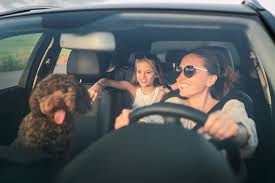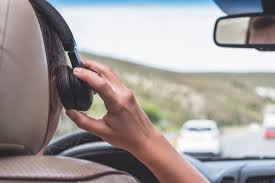DISTRACTED DRIVING
Dealing With Children or Pets

1. Introduction
Children and pets can create sudden, unpredictable distractions inside a vehicle. Whether they are crying, arguing, moving around, or needing attention, a driver may feel tempted to turn around, comfort them, or intervene. These actions take the driver’s eyes, hands, and mind away from the road—leading to one of the most dangerous forms of in-car distraction.
2. How Children and Pets Distract Drivers
This type of distraction is especially dangerous because it combines multiple elements at once:
• Manual Distraction
The driver may reach back, hold items, hand over snacks, or restrain a pet or child.
• Visual Distraction
The driver looks away from the road to check on the child or pet.
• Cognitive Distraction
The driver becomes emotionally invested—worried, frustrated, or panicked—making it harder to concentrate on driving.
This triple distraction is responsible for many avoidable accidents.
3. Common High-Risk Situations
Children or pets may:
- Cry, scream, or fight
- Drop items and ask the driver to pick them
- Remove seatbelts or car-seat straps
- Move around or stand up in the car
- Throw objects or spill food
- Demand the driver’s attention
- Pets may roam freely, jump onto the driver’s lap, or block the pedals
Any of these situations can quickly lead to loss of control.
4. Why This Is Dangerous
Dealing with children or pets while driving can cause:
- Taking eyes off the road for long periods
- Drifting into other lanes
- Delayed reaction to sudden hazards
- Overcorrecting the steering
- Increased stress, which affects judgment
- Complete loss of vehicle control if a child or pet interferes physically
Even a moment of distraction while traveling at high speed can be fatal.
5. Realistic Examples
Example 1:
A crying child causes the driver to turn around for a second, resulting in a rear-end collision.
Example 2:
A pet jumps toward the driver, leading to swerving into another lane.
Example 3:
A toddler drops a bottle, and the driver bends down to pick it up, losing control of the vehicle.
Example 4:
Two children arguing distract the driver, causing them to miss a pedestrian crossing ahead.
6. Prevention Strategies
Effective strategies ensure safety for both the driver and passengers:
Before Driving:
- Secure children properly in approved car seats
- Ensure pets are restrained using carriers, crates, or pet seatbelts
- Provide snacks, toys, or devices to keep children occupied
- Make sure everyone is comfortable before starting the trip
During the Trip:
- Never turn around while the car is moving
- Pull over safely if a child or pet needs attention
- Use mirrors to check on children instead of turning your head
- Set rules: no yelling, no unbuckling, no moving between seats
- Ask an older child or passenger to help manage others
For Pets:
- Never allow pets on the driver’s lap
- Keep pets out of the front seat
- Use pet barriers or harnesses to prevent movement
7. Key Takeaway
Children and pets can be unpredictable and demanding, but responding to them while driving can cause severe accidents. Safe drivers secure passengers properly, stay focused on the road, and pull over whenever attention is needed. Protecting the family starts with keeping both hands, eyes, and mind on the road.
Related Tutorials

DISTRACTED DRIVING
Emotional Distraction
1. What It IsEmotional distraction occurs when strong feelings—anger, sadness, stress, e...
Read More
DISTRACTED DRIVING
Wearing or Adjusting Headphones/Earbuds
1. What It IsAdjusting headphones or earbuds while driving is a form of manual and visual ...
Read More
DISTRACTED DRIVING
Daydreaming / Mental Distraction
1. IntroductionDaydreaming—also called mental distraction—is one of the most common ye...
Read More